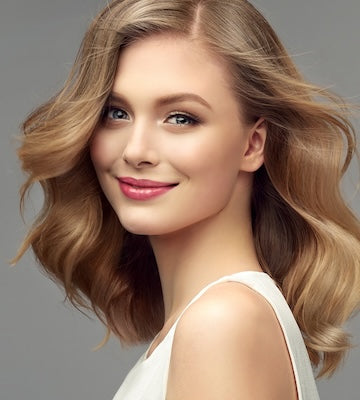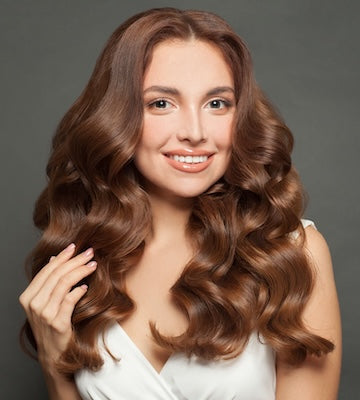Hair thinning and shedding affect millions of women, often quietly. But the good news is there are ways to encourage hair regrowth, restore volume and feel like yourself again. Here’s hair regrowth therapy explained.
Hair loss is rarely just about hair. For most of us, it's tangled up with confidence, identity and how we present ourselves to the world. So if you’ve noticed more hair on your pillow, your hair doesn’t look as full, or thinning patches at the crown or temples, it matters. And you’re probably searching for solutions.
Firstly, you’re not alone. There are many options out there to restore your hair’s natural health and volume.
One common route is hair regrowth therapy: an umbrella term that covers both clinical treatments and “at-home” techniques to reverse hair loss and improve volume.
In this guide, we’ll break down what hair regrowth therapy means, what the science says, and how you can support your hair’s health - whether through treatment, styling or something like the right haircut.
What is hair regrowth therapy?
In short, hair regrowth therapy refers to any hair loss treatment designed to stimulate dormant hair follicles, extend the growth phase of your hair, or slow down shedding. It’s not one single product or procedure. Instead, it covers a range of hair regrowth treatments (like topical products, red light therapy and even transplants) that work to support your hair’s natural cycles.
Before we get into the details, here’s some background to help things make sense.
Your hair grows in three main phases:
-
Anagen: the growth phase (this is where you want your follicles to stay as long as possible)
-
Catagen: a short transition phase
- Telogen: the resting phase, where hair eventually sheds
In healthy hair growth, most hair is in the anagen phase (usually about 85-90% at any one time). But when hormonal changes (for instance, postpartum or menopause), stress, diet or genetics come into play, more hairs move into the telogen phase, and you may get visible thinning.
Hair regrowth therapy aims to rebalance this cycle. Depending on the cause of hair loss, this could mean improving scalp circulation, blocking certain hormones, reducing inflammation or encouraging stem cell activity in the follicles.
Does hair regrowth therapy work?
In many cases, yes - hair regrowth therapy can absolutely work. But it’s not instant, and it’s not a magic wand. Hair regrowth therapy works best when started early, when the follicles are still active rather than completely closed.
Let’s explore six common types of hair regrowth treatment and how they work in practice.
1. Minoxidil
Minoxidil is one of the most well-known over-the-counter hair regrowth treatments, often sold under brand names like Regaine. It’s a topical foam or liquid that you apply directly to your scalp.
One of the main ways it works is increasing blood flow to the scalp, helping hair follicles get the oxygen and nutrients they need to stay in the growth phase longer. This also helps reverse something called “follicle miniaturisation”, stimulating growth of longer, thicker hairs.
Many women see good results with minoxidil, especially if they start early and use it consistently for at least 4–6 months. It’s often used as a first step in other treatments for hair loss or thinning.
2. Finasteride
Finasteride is a common hair loss treatment, usually only prescribed to men. It works by blocking the hormone DHT (a form of testosterone), which can shrink hair follicles over time. It’s a particular risk for pregnancy, which is why it’s generally avoided for women.
For male pattern baldness, it can be quite effective. But for women, doctors may consider alternative routes like HRT as part of a broader hair loss treatment plan.
3. PRP therapy (Platelet-Rich Plasma)
This one sounds intense, but it’s actually pretty fascinating. PRP therapy uses your own blood, spun in a machine to separate the plasma (which is rich in growth factors), then injected back into your scalp. This helps stimulate hair follicles and kickstart growth.
Can PRP regrow hair?
PRP isn’t a miracle cure, but it has real potential for early to moderate hair thinning. The growth factors in PRP help “wake up” follicles that are dormant but still alive, encouraging them to produce thicker, healthier strands. Many women who try PRP notice shedding slows and density increases - especially around the crown or temples where thinning often begins.
The best results tend to come from a course of 3–4 sessions, spaced a few weeks apart. Maintenance treatments are then needed every few months. It’s not suitable for everyone (and results vary) but it’s one of the more natural and less invasive hair treatments to promote growth.
PRP is also often paired with laser hair regrowth therapy for better results…
4. Low-level laser therapy (LLLT)
If the idea of lasers sounds futuristic, you’re not far off. LLLT involves using red light therapy for hair growth (usually through a cap or comb), to stimulate cellular activity in your follicles. The light penetrates the scalp and encourages mitochondria (the cell’s energy centres) to boost activity and support hair growth.
It’s a gentle and pain-free method, suitable for home use. While results vary, many women find it helps maintain density alongside other treatments like minoxidil or PRP.
Does laser hair regrowth therapy work?
Laser hair growth therapy might be a gentler option, but that doesn’t mean it’s ineffective. In fact, red light hair growth treatments reduce inflammation, improve circulation and stimulate energy production in hair follicle cells. This all nudges hair back into a growth phase.
The key to success with laser hair growth is consistency. You’ll need to use it regularly - often several times a week - for a few months to see results. And while it won’t work for everyone, it’s widely considered one of the best treatments for hair loss when used alongside other therapies.
5. Stem cell therapy
Stem cell therapy for hair regrowth is one of the newer and more advanced options in hair health. While it might sound like science fiction, it’s based on a powerful principle: regeneration.
Where PRP encourages healing using your blood’s growth factors, stem cell therapy goes one step further, using actual stem cells to repair and regenerate damaged hair follicles. These cells either come from your body (usually fat tissue or the scalp itself) or derived from donated tissue, depending on the treatment type.
How is stem cell therapy done for hair regrowth?
In a typical procedure, a small sample of fat tissue is taken from your body, processed in a lab to isolate stem cells, then injected into the scalp. These stem cells help rejuvenate ageing follicles, promote blood supply and encourage new growth.
It’s an evolving field and clinical trials are ongoing, but early results are promising, especially for people who haven’t responded to traditional therapies.
While it’s more expensive than PRP or laser treatment (with figures easily reaching £1,000 or more per session, with 3-6 initial treatments and maintenance sessions required), stem cell therapy is rapidly becoming a popular choice.
6. Hair transplants
When hair loss becomes more advanced and “standard” hair regrowth treatments aren’t doing enough, some women turn to transplants. This involves moving follicles from a thicker part of the scalp (usually the back) to thinning areas. It's a more permanent and targeted solution but it’s also a big commitment, with a longer recovery period and higher costs.

Which therapy is best for hair regrowth?
When choosing hair regrowth therapy, the best treatment depends on you - your hair type, causes of hair loss, budget and personal preferences. Some women get great results with minoxidil alone, while others benefit from combining treatments like PRP, low-level laser therapy, or even stem cell therapy for hair regrowth.
Here’s an idea of what might work best, depending on your situation:
-
Early signs of thinning: Minoxidil is a good first step, often included in other hair loss treatment plans
-
Shedding linked to stress or hormones: PRP or lifestyle-based approaches may help, especially when paired with natural hair treatments (like scalp massage) to promote growth
-
Scalp sensitivity or inflammation: Laser hair growth therapy is a gentle approach that improves circulation and reduces stress on follicles (also helping general scalp health)
- Thinning around your crown or temples: A more targeted approach - like PRP, transplants or strategically placed hair extensions - can restore volume while giving your natural hair time to recover.
The important thing is to start gently, consistently, and as early as possible. Make sure to consult your GP or hair specialist before starting any new hair loss treatment plans. They’ll advise on the best route and investigate any underlying causes.
Is hair regrowth treatment worth it?
If you’re considering hair regrowth treatment, this is the big question. With costs ranging from around £30 for a bottle of minoxidil to £1,000 or more for a stem cell therapy session, it’s no small undertaking. Of course, there’s also investment in time and effort. So, is it worth it?
In many cases, yes, hair regrowth therapy is really worth it. Especially if hair loss is affecting your self-esteem or if you catch it early.
That said, it’s important to go in with realistic expectations. Most treatments won’t make your hair suddenly return to its full youthful volume. But they can help you keep the hair you have for longer and thicken thinning areas.
Here’s a quick breakdown of the main pros and cons:
Pros:
- Can slow or stop further loss when caught early
- Some treatments offer visible thickening and regrowth within six months
- Boosts confidence and self-esteem
- A wide range of non-invasive and gentle options
- Some therapies (like PRP or laser hair growth) use your body’s natural healing response
Cons:
- Results take time - typically 6 months minimum
- Treatments often need to be ongoing to maintain progress
- Some products can cause irritation or temporary shedding
- Medical treatments may not be suitable during pregnancy
- Not every treatment works for every person
Ultimately, the best treatment for hair loss is the one that works for your lifestyle, your body and your confidence.
Which haircut is best for hair regrowth?
To round off, let’s chat about supporting hair regrowth in natural ways. As part of this, the haircut and hairstyles you choose are two of the most important factors for hair health and appearance.
A cut can do more than tidy up the ends. It encourages healthier hair by reducing breakage, minimising tension and making thinning less noticeable. Sometimes, a strategic trim is one of the most underrated hair treatments to promote growth - especially when combined with PRP or laser hair regrowth therapy.
If your ends are splitting or weak, trimming stops damage travelling up the shaft. And if you’re experiencing thinning at the crown or temples, the right style can add the illusion of fullness and frame your face in a flattering way.
Here are a few styles that work particularly well for regrowth:
-
Blunt cuts: These keep the ends looking dense and can give finer or thinning hair a thicker appearance. Avoid excessive layering, which can make hair look sparser
-
Soft, graduated bobs: A gentle angle adds shape and bounce without weighing-down fragile strands
-
Shoulder-length styles: Long enough to style, short enough to stay strong. Great for managing breakage while maintaining flexibility
- Pixie cuts or short crops: If you're ready to start fresh, these styles can remove damaged hair and create a low-maintenance foundation for new growth.
What hairstyle is healthiest for your hair?
Once you’ve chosen a hairstyle that feels right for you, how you wear your hair matters as much as the treatments you use. The healthiest hairstyles are the ones that avoid unnecessary tension, heat and friction. But most importantly, listen to your scalp. If a style pulls, rubs, or breaks hairs as you undo it, it’s probably not doing your hair any favours.
Gentle, low-stress styles give your follicles the freedom to do what they do best:
-
Avoid tight styles: Constant pulling from ponytails, tight buns or braids can lead to traction alopecia (hair loss caused by stress on the follicle)
-
Change your parting regularly: Always styling your hair the same way can cause thinning along that line. Changing your parting gives your hair a break and can even add a volume boost
-
Use protective styles thoughtfully: Braids, buns, or twists can reduce daily wear and tear, but they should be gentle and not overly tight at the roots
-
Minimise heat styling: Blow-drying, curling and straightening all take a toll over time. Embracing your natural texture - or air drying - can prevent breakage and keep regrowing hair intact
- Switch to soft fabrics: Accessories like satin scrunchies or microfibre towels reduce friction while you sleep or style, giving fragile new hairs their best chance at surviving
At Phoenix Crown, we know hair isn’t just about looks - it’s about identity, empowerment and self-expression. If you’re noticing thinning or volume loss we offer luxury pure Virgin hair extensions designed to restore fullness and confidence - beautifully and discreetly.
Whether you want to add subtle volume or go all-in with a glamorous transformation, our tailored extensions support your natural beauty and help you feel your best. Explore our full range and support your hair regrowth journey with Phoenix Crown.










